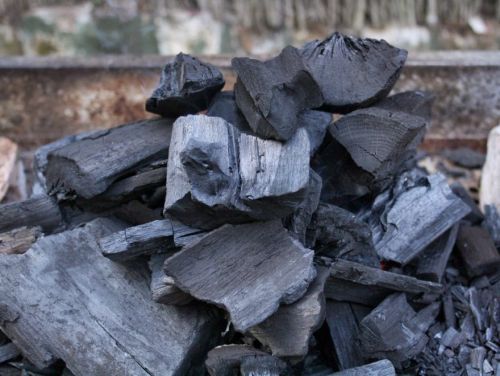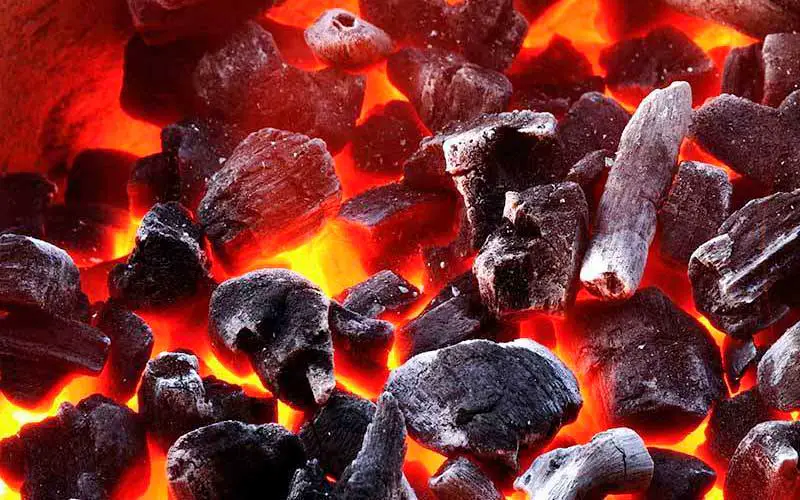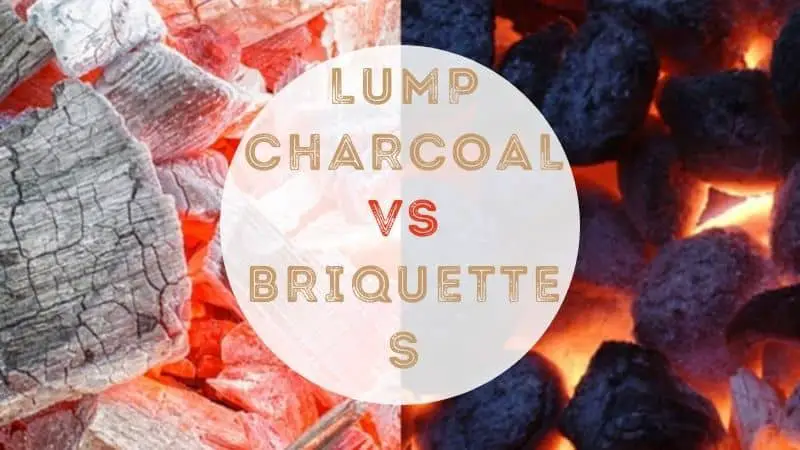When it comes to creating a fire, there are usually two options: using lump charcoal or briquettes. Many new grillers don’t understand the difference between the two and often use them interchangeably when buying starter materials for their next bonfire. However, this can lead to problems if you don’t know what each ‘type’ of charcoal actually is and how they’re different from one another. Here we’ll outline what you need to know about both forms of coal so that you always get the most out of your barbecue experience!
The Difference Between Lump Charcoal and Briquettes?
First, let’s tackle lump charcoal vs. briquettes. As mentioned above, the main difference between the two is that lump charcoal isn’t actually ‘coal’ in the conventional sense. Instead, it’s pieces of wood that burn much hotter than briquettes, but also burn up quicker too. Briquettes are small pieces of coal, formed together in order to produce a longer-burning fire. On average you should be able to get about three hours out of a single briquette while lump charcoal will only last for around an hour and a half when burned directly beneath food on your grill grates.
What is Lump Charcoal?
Lump charcoal, as mentioned above, comes from pieces of burnt wood rather than the traditional underground vein found in most types of coal. This high-quality fuel can come from either scrap or virgin timber, with the latter producing a higher heat output.

A Quick Guide to Lump Charcoal
- It’s made using pieces of wood instead of traditional coal. However, there are still many types of tree that can be used to create it!
- It burns hotter than briquettes but also burns out more quickly too.
- It comes in either ‘scrap’ or ‘virgin’ forms; the former is cheaper but produces less heat, while the latter will burn for longer.
When it comes to choosing your charcoal, one of the most important factors will be how much heat is produced. Lump charcoal can burn up to three times hotter than briquettes, giving you that searing cooking heat that’s needed for great barbecues!
However, this also means that your lump charcoal will only last around an hour and a half before needing replenishing. On the other hand , briquettes are made from ground down coal which makes them more time-consuming to produce (it takes 24 hours for them to go through the ‘briquetting’ process). However, they’ll burn out far slower than a lump variants, allowing you to cook over them for about three hours on.
What is Briquette Charcoal?
Briquettes are small pieces of coal formed together under high pressure so that they eventually become dense enough to last for several hours when burned on your grill. This type of charcoal is actually the more traditional option when it comes to barbecue fuel.

A Quick Guide to Briquette Charcoal
- It’s made using pieces of coal rather than wood.
- Longer burning than lump charcoal, it still produces less heat though!
- The resulting ‘briquettes’ burn for between 90 minutes and three hours depending on how many you use on your grill .
- Unlike lump charcoal, briquettes do not burn as hot but they do last longer. They’re perfect for smoking food over an extended period of time as opposed to grilling meat directly over a flame.
Note In recent years there has been much controversy over whether or not briquette charcoal is actually more environmentally friendly than lump charcoal. This is because, in order to make them, coal dust must be produced by the coking process. While this gas can then be used for heating purposes it also creates a large amount of pollution!
Compare Lump Charcoal vs Briquettes
While they’re both forms of charcoal, there are some major differences between lump charcoal vs. briquettes that every bonfire fan should know about! Lump coal is made entirely from pieces of burnt wood instead of traditional coal veins meaning that it will burn three times hotter than briquettes.
However, they also burn out much quicker; you won’t get more than an hour and a half’s worth of heat from one lump charcoal briquette placed below food directly on the grill grate . Briquettes are made by forming small pieces of coal into larger ones which is why they’ll burn at a lower temperature for longer.
You can expect to cook over these bad boys for about three hours before needing to replace them . Another thing to consider with both types is what you’d like your final product to taste like!
Lump charcoal tends to give whatever is being cooked its own distinct flavour whilequettes create something more subtle. That’s because lump charcoal is made out of pure pieces of wood whereas briquettes are formed primarily from coal, making them more ‘coal-like’.
Which is Better for Grilling, Smoking, or Baking?
Lump charcoal is typically the better choice for grilling, especially if you want to get serious about your meat. Since it burns hotter than briquettes but has a shorter life span, you’ll need to be vigilant about checking on it throughout the cooking process. This will allow you to maintain an optimal cooking temp and ensure that your food cooks thoroughly without burning. It’s also worth noting that lump charcoal can give off more ash than briquettes, which can contribute to flavor loss if not properly contained (please remember that you should only use 100% hardwood lump charcoal for grilling).

As we mentioned earlier, briquettes are made from actual coal and produce a longer-lasting fire due to their compact construction. The downside here is that they take around 30 minutes to get going compared to the 10-minute mark of lump charcoal. However, this can be a positive thing if you want to keep your food warm before cooking.
Briquettes are better for smoking than grilling but can also be used in place of lump charcoal when baking or roasting too. If you’re using briquettes for other purposes then it’s worth checking out Weber Lump Charcoal Briquets which were designed specifically for ovens and smokers. They give off less ash than standard bagged briquettes, thus creating an ideal cooking environment with fewer flavor problems (i.e., no excess ash or burnt bits).
Just remember that while both briquettes and lump charcoal can be used for both grilling and barbecuing, only one of these charcoal types should be used in baking or smoking. Doing so will result in either your meats being undercooked (lump) or with no color at all (briquettes).
The choice between lump charcoal vs briquettes is really down to personal preference. You can’t go wrong with either type of coal, but it’s important to know the pros and cons of each before you make a purchase. If you’re new to cooking with coal then we recommend choosing briquettes first as they are easier to light and maintain than lump charcoal. This will make them ideal for beginners who want to try out their first grill or without risking wasting any food!
What Are Some Other Types of Charcoal That I Could Use?
Aside from lump charcoal vs . briquettes or even compressed charcoal, there are several other types to choose from too – here’s the lowdown on each so you can pick your favorite:
- Natural Lump Charcoal: As mentioned above, natural lump charcoals come in either virgin or scrap forms. You can expect around three hours worth of heat out of any type that’s made from virgin timber. For those that are scrap, you’ll probably only get about an hour and a half worth of heat before the burnout.
- Charcoal Briquettes: As discussed above, briquettes originate as coal dust produced during the cooking process which is then formed into small balls and compressed together under high pressure. They will burn for between 90 minutes and three hours depending on how many you use – although we obviously recommend using less than this if possible!
- Lumpwood®: A revolutionary new type of charcoal that’s environmentally friendly and arguably even better than traditional lumpwood because it doesn’t produce any smoke or ash. Plus, the charred wood pieces that go into making it come from 100% recycled material meaning you’re really doing the planet a favor with every bag of Lumpwood® you buy.
- Hardwood Charcoal: Hardwood charcoals come from a sustainable source and, instead of producing smoke or ash, cook your food using an oxygen reduced environment to produce a far healthier end result.
- Coconut Shell Charcoal: This type is made by collecting the husks of coconuts that have been burned in traditional brick kilns and then ground into charcoal dust before being formed into briquettes. These are perfect for grilling meat because they burn so hot!
How to Use Lump Charcoal vs Briquettes
Now that you’re familiar with the difference between these two forms of solid fuel, let’s look at how best to use them when BBQing. We’ll go into more depth about this below but here are some quick tips to get you started:
- Both forms of charcoal should be prepped before lighting your grill. This means opening up all vents and placing newspaper underneath your coals.
- If you are using briquettes, it’s best to light them in a chimney starter instead of directly on your grill grates. This will allow the pieces to light evenly rather than burning only the top layer!
- Once lit, both forms of coal should be placed evenly under food. Since they burn at different rates, this allows for more accurate cooking times too!
- Use tongs or other utensils to handle these coals carefully while out on the grill – they’re hot, after all!
Conclusion
It’s clear that both briquettes and lump charcoal produce different results which is why it’s important to use the right one for the job! If you’re short on time (or patience) then stick with briquettes as they’ll provide consistent heat over a three-hour period; however if you want something that will sear your food then go with lump charcoal . Whatever you choose, it’s important to be familiar with what each variant does before starting any barbecue.
